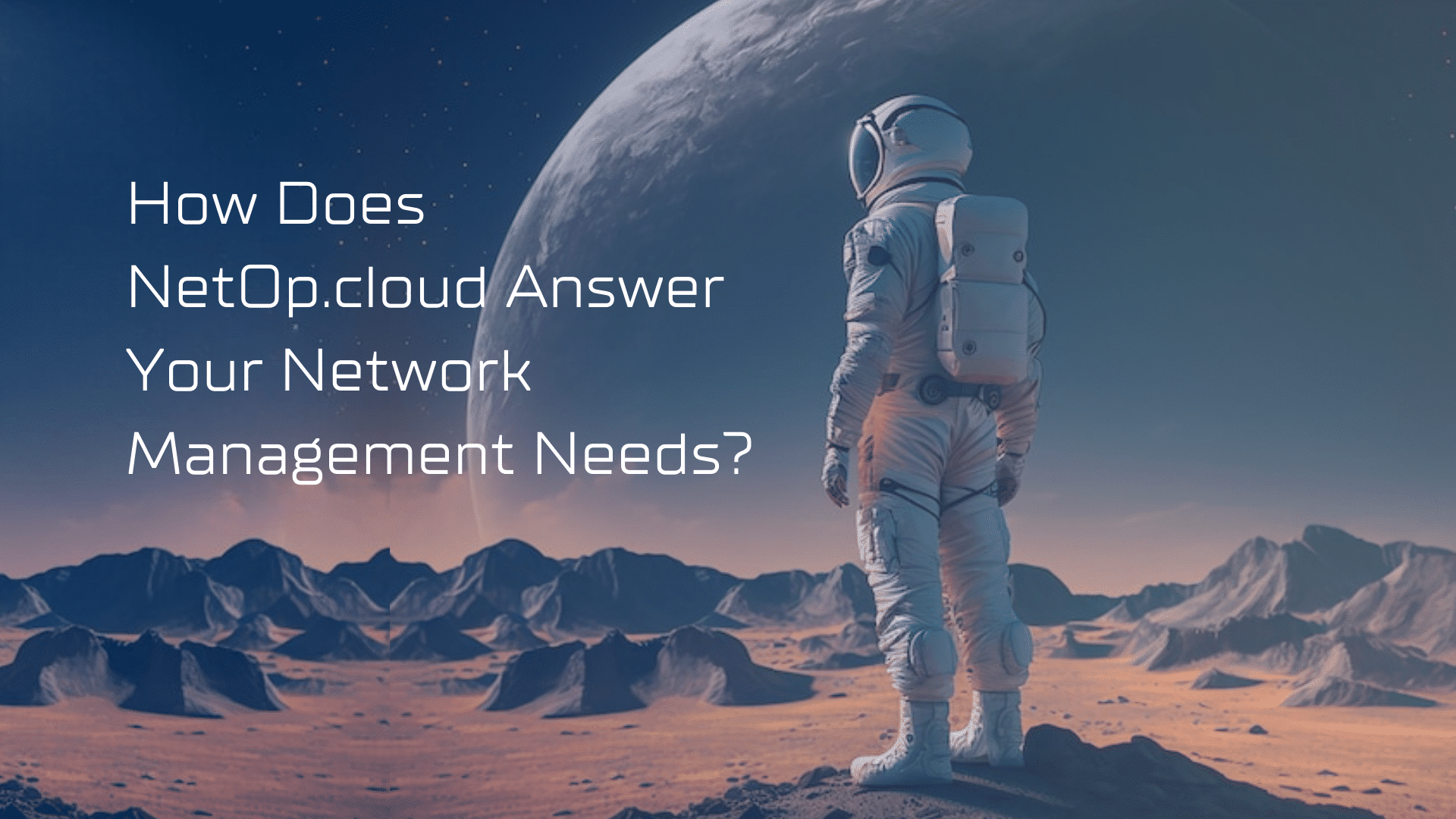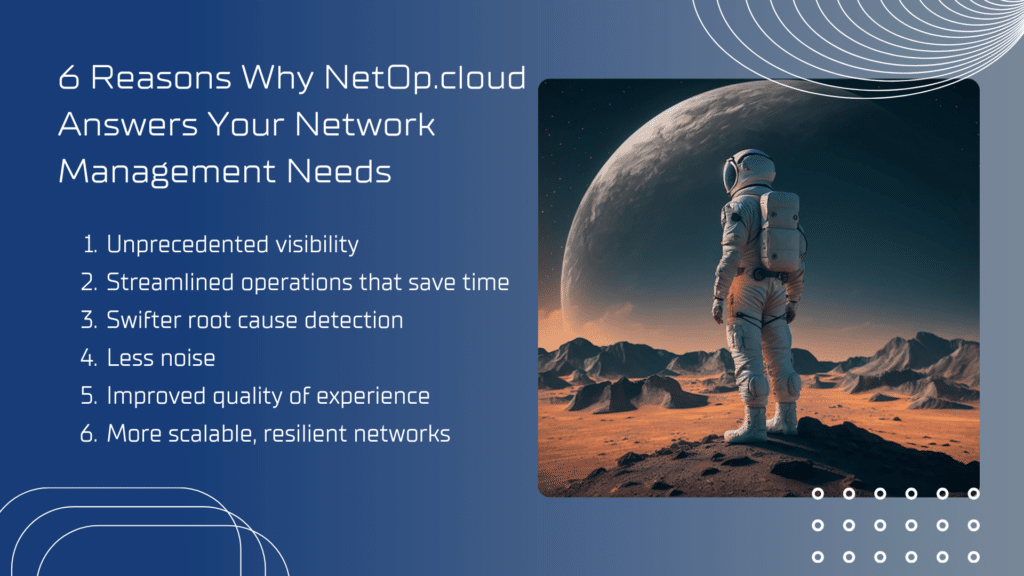6 Reasons Why NetOp Answers Your Network Management Needs

Network management has never been more crucial, or more challenging. Today’s networks are complex and enormous, spanning multiple vendors, devices, applications, locations, and cloud connections. Fast, always-available internet is now a basic enterprise need.
As a result, IT managers are under intense pressure for high internet availability and performance, but they are handicapped by a lack of visibility across multi cloud environments. This makes it time consuming and frustrating for them to pinpoint the source of difficulties when user experience drops.
Thankfully, NetOp is here to help, with unique capabilities and features that empower network operations teams to manage networks with less hassle, less stress, and more efficiency. Our advanced, AI-based, network management platform automates network monitoring and operations in an intuitive, vendor-agnostic solution. Here is what NetOp can do for your network management.
1. Unprecedented visibility
One of the biggest drawbacks to today’s extensive networks is that they are extremely difficult to map and monitor. NetOp changes that with powerful mapping, AI-monitoring, and comprehensive data collection that opens up visibility into every corner of the most complicated multi-vendor environment.
Unlike other tools, NetOp is vendor agnostic, so it collects data from cloud, legacy, and mixed networks. It automatically produces a detailed, dynamic topology map of your network, so you can navigate from a high level view to the granular details of each individual element, as well as tracing all the connections between them. Without NetOp, this is close to impossible to achieve.
Recommended reading: Top 7 Benefits of Using AI for Network Monitoring and Operations
NetOp also gathers and stores data that other solutions overlook, like information about your WiFi connections so you can see what lies behind poor signals or weak connections. The solution retains historical data for a long time, providing powerful investigative capabilities that allow you to manually explore and gain insights into any situation or incident. Our AI monitoring captures every change across the network.
Last but not least, all this information is easy to view and absorb. The NetOp dashboard shows you the state of all your physical and logical networks in a single glance, while making it easy to drill down into detailed information. You can plot any metrics you like in one graph to help with correlation and trouble-shooting.
2. Streamlined operations that save time
Managing the extensive sprawl of an enterprise IT system requires a massive amount of time and effort, which is always in short supply for IT teams and network managers. NetOp eases the burden by simplifying workflows and processes in a number of ways.
One of our most valuable features is the Incidents feature. This correlates all current anomalies in a single location to produce valuable insights that guide the network management team to the root cause of the problem, accompanied by recommendations about the best ways to resolve the issue.
For example, someone holding a Zoom video call might sometimes find their connection freezes, is interrupted, or has choppy audio and video. NetOp collects all the relevant application level performance metrics such as latency, packet loss and much more, to find the root cause. The network manager receives just one alert about the issue, together with information about the root cause and how to resolve it.
NetOp also collects masses of data relating to relevant applications, and refines it into a single Quality of Experience (QoE) metric. This gives the IT manager a simple frame of reference that lets them know what the user is experiencing at a glance, saving the mental load of calculating the impact of different metrics. Our unified dashboard includes health scores and easy to understand indicators for each individual part of the network and the network overall.
Recommended reading: Understanding MOS and Its Importance for IT Network Managers
Additionally, NetOp’s automation makes it possible to roll out mass configurations across the entire network using automated intent-based networking. For example, instead of network configuration tasks like manually configuring guest networks across 100 sites, one at a time, you could select all the relevant networks and apply the new configurations in a couple of clicks. This frees network managers for work that drives value.
3. Swifter root cause detection
Because enterprise networks have become so vast, both in terms of size and complexity, root cause detection can be a nightmare quest through an Escher-esque landscape. Network managers can struggle for hours to pinpoint the source of a problem and then expend more hours on understanding how it arose, while frustration rises from users and clients.
NetOp’s Incidents feature offers a shortcut to root cause detection. By aggregating all the anomalies regarding the incident and correlating the data it gathers across all parameter metrics such as traffic utilization, CPU, memory and much more, it can discover the ultimate cause of the drop in user experience.
4. Less noise
In theory, network alerts are an excellent way to notify IT managers about issues in the system, whether that’s an attempted cyber attack or unreasonable lag on a video call. In practice, IT teams are overwhelmed with alerts, many of which are false positives or relatively minor, leading to high stress levels and sometimes to “alert blindness.”
NetOp’s anomaly aggregation correlates every anomaly into a single ticket for each incident, resulting in fewer alerts. Anomalies are further grouped by category, making it easier to scan the data and understand the situation quickly. IT managers can choose when to receive alert emails, e.g. whenever an incident ticket is opened, or closed, or when severity increases, or once a day, etc.
What’s more, NetOp’s AI capabilities sift through the slew of anomalies to discard those which aren’t relevant or might distract you from your investigation, leaving far less noise for network managers to contend with. False positives and unimportant issues are removed or deprioritized, leaving network management teams with more energy to focus on the issues that really matter.

5. Improved quality of experience
NetOp delivers higher uptime, increased performance levels, and better quality of experience for the end user. Our simple Quality of Experience metric informs network managers about any drop in user experience immediately, often before anyone opens a ticket. With this type of advance notice, it’s often possible to resolve the issue before the user notices any change in network performance. For example, in the above case of the poor quality Zoom call, the network manager could deal with the underlying issue while the call is still ongoing.
NetOp’s Incidents feature also assists in this regard. Automated diagnoses, valuable observations about network conditions, and effective recommendations assist network management teams to identify the root cause and resolve the issue much more quickly, minimizing network downtime or reduced performance.
Recommended reading: Top Strategies for Enhancing Network Performance
Additionally, our AI-powered monitoring systems can detect early signs of network failures, so that IT teams can proactively address the issue before it affects network performance. They can also spot patterns in network conditions and user demand to dynamically and proactively adapt bandwidth allocation, routing, and other parameters, so as to allocate resources more efficiently and improve QoE.
6. More scalable, resilient networks
NetOp assists network managers to future-proof networks and make them more scalable to any changes in network conditions, whether that’s an increase in demand, attempted hacking, or new business strategies.
The automated anomaly detection and incident resolution mean that issues can be resolved while they are still minor and easily dealt with, reducing the risks of major incidents that might bring the network down. Automated configuration tools allow IT teams to provision and deploy new subnets, networks, or entire network sites in minutes, while reducing the risk of errors that can result in delays, or even crash the network.
AI-powered continuous network monitoring can spot vulnerabilities and detect potential threats that might be overlooked by human surveillance. Automatic scheduling for security patches and updates help close up loopholes in your cyber defenses and protect networks from opportunistic cybercriminals. Together, they build more robust networks.
Stronger networks, here we come
With NetOp, you can oversee a more robust and resilient network that has higher availability and performance, with less stress and frustration. Our unique features save time and irritation for network managers, enabling them to meet and exceed user expectations without needing to add more resources.
Find out what NetOp can do for your network management today!

